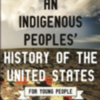An Indigenous Peoples’ History offers a needed, yet often unheard perspective on United States history.
An Indigenous Peoples’ History consistently poses questions that counteract misinformation about Native communities, specifically stories that are usually taught in elementary school. This lends itself to fantastic conversations on whose history is taught in school, and offers students a chance to recognize whose curriculum they’re expected to learn for standardized tests.
And unlike many textbooks, this work does not spare discussions about modern events that are shaped by history. It brings up the intolerance of sports team naming, the lack of Native representation in Hamilton, and deciphers political rhetoric vs. reality. All of these are framed around easily adapted class discussions that speak to the heart of a history class: a voice for the oppressed, a deep understanding of the United States’ genocidal past, and an outlet for modern day political understanding.
Further, An Indigenous Peoples’ History doesn’t stop at an arbitrary point after colonialism like most United States textbooks do. Native people do not disappear. This work goes through the modern era and speaks of DAPL and Standing Rock. It traces each element of this nation’s history and demonstrates how the modern world intertwines itself in its past, often horrific, decisions.
Due to its easy adaptability and readability, this work could fit into any established curriculum:
- The Humanities as an obvious choice for non-fiction reading that leads to grappling and needed discussions.
- Mathematics and science for social justice through the policies and environmental connections laid within.
- The arts and music for the influence and cultural importance of Indigenous cultures.
To read more of Chris McNutt's article, please click here.



Comments (0)